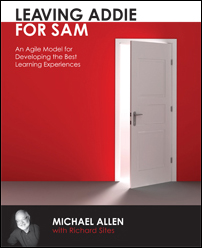Blog
Is Every Process Really ADDIE?
by Richard Sites, vice president - client services, @rhillsites


ADDIE: By Any Other Name Would Smell As Sweet…
By Richard Sites | September 27, 2012 | Custom Learning | 0 Comments
 by Richard Sites, vice president - client services, @rhillsites
by Richard Sites, vice president - client services, @rhillsites
Yesterday I had a wonderful opportunity to participate in an ASTD webinar with Michael Allen to discuss the new book I co-authored with him, Leaving ADDIE for SAM.
After being approached by ASTD to write a book about the Successive Approximation Model (which we call SAM), a model we at Allen Interactions have used for twenty years, Michael and I started discussing how to best present this model to the industry -- especially since this is not the first book Michael has written on the subject.
Our first thought was to build the case for why we do things differently. It seemed logical to use ADDIE as the baseline for current instructional design practices, especially since a large majority of the clients and instructional designers we work with profess to use it.
1.jpg) This led us to the next challenge: What is ADDIE? Most of us are familiar with the five components of ADDIE: Analyze, Design, Develop, Implement and Evaluate. But it seems that this is where the general consensus ends. The original intent of ADDIE was a standardized method for creating large quantities of training. The traditional ADDIE process follows the order of the acronym, A-D-D-I-E, where one task leads to the next in a linear fashion. It proposes a very manageable comprehensive approach to building instructional events and materials.
This led us to the next challenge: What is ADDIE? Most of us are familiar with the five components of ADDIE: Analyze, Design, Develop, Implement and Evaluate. But it seems that this is where the general consensus ends. The original intent of ADDIE was a standardized method for creating large quantities of training. The traditional ADDIE process follows the order of the acronym, A-D-D-I-E, where one task leads to the next in a linear fashion. It proposes a very manageable comprehensive approach to building instructional events and materials.
Over the years as new technologies, challenges, and opportunities have surfaced, people have altered the order or changed the linear sequence requirements in an attempt to make ADDIE more representative of the real workflow that instructional designers are experiencing. These modifications are smart and necessary, there’s no doubt about that, but as a consequence it seems that no one’s experience of ADDIE in practice is exactly the same.
In Leaving ADDIE for SAM, Michael and I offer a definition of ADDIE as a linear, waterfall model of instructional design. After all, this was the original intent. We used this definition to build a rationale for the need of a new process which acknowledges and represents the challenges that face our profession. We believe, and have for years, that ADDIE in its ordered, waterfall sequence does not meet the needs of many instructional designers and developers of learning experiences. The new book provides an alternative process we believe better represents the sequence you already follow.
The response on the webinar yesterday (as it has been for the past decade) was passionate and pointed; supportive and inquisitive. There are those who say ADDIE is dynamic and flexible, that evaluation is a part of every task and that there are now arrows connecting all tasks.
But, these statements only highlight a core problem in our industry …do we even collectively agree on what ADDIE represents or is? Or more importantly, are we doing a disservice to our profession if we all do what we believe to be the best approach and call it ADDIE?
“What's in a name? that which we call a rose
By any other name would smell as sweet;”
Even Juliet understands our challenge!
Get your copy of Leaving ADDIE for SAM at ASTD.org
Download the Complimentary Preface Here

About the Author: Richard Sites
Comments
Would you like to leave a comment?
Related Blog Posts

By: Richard Sites | Jan, 2014
Category: Custom Learning, Strategic Consulting

Blog
Happy Anniversary to Leaving ADDIE for SAM!
by Richard Sites, vice president - client services, @rhillsites
By: Richard Sites | Sep, 2013
Category: Custom Learning, Strategic Consulting, Dr. Michael Allen

Blog
Iterative e-Learning Development: SAM Uncovered
by Richard Sites, vice president - client services, @rhillsites
By: Richard Sites | Apr, 2014
Category: Custom Learning, Strategic Consulting
